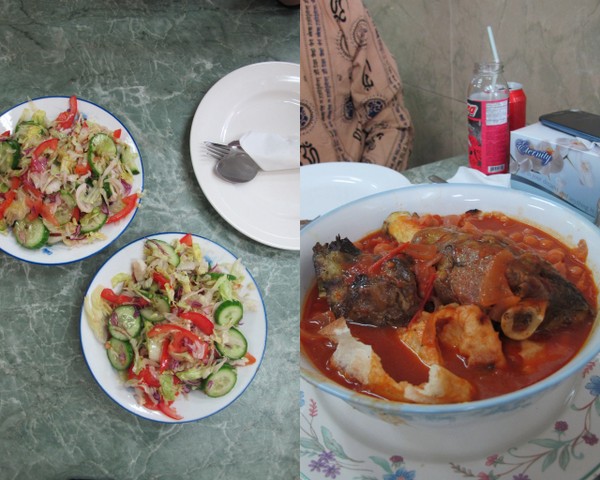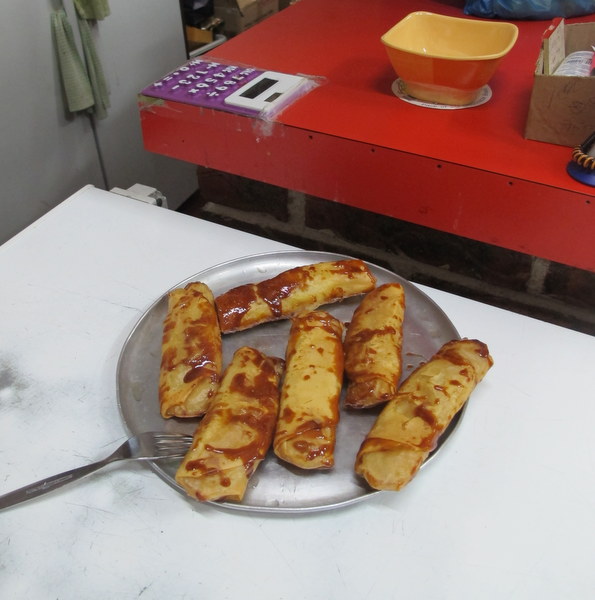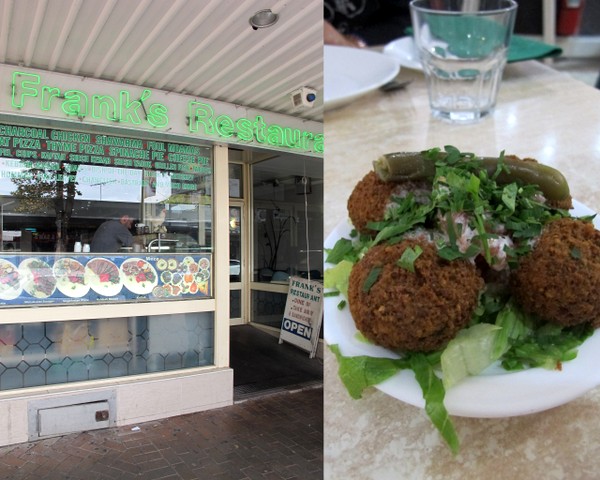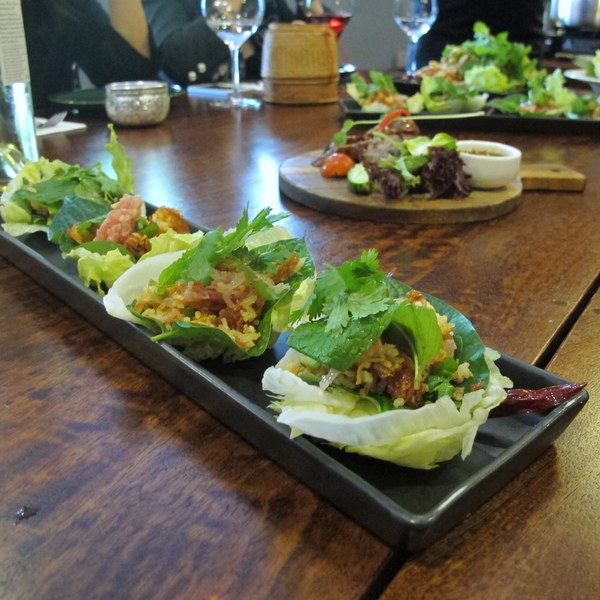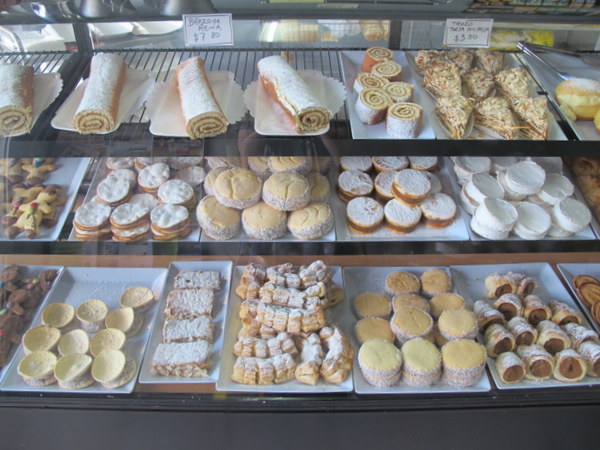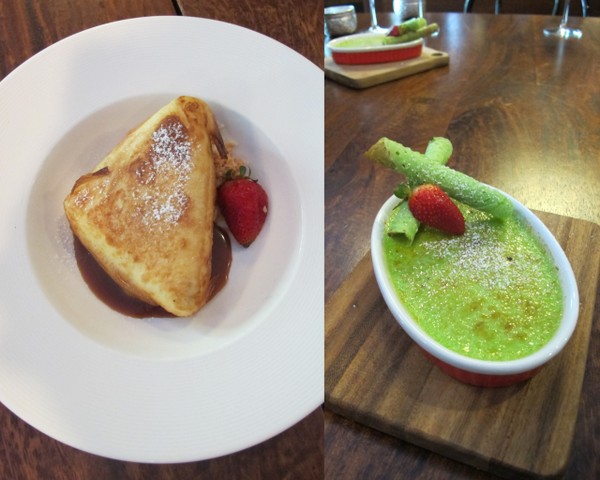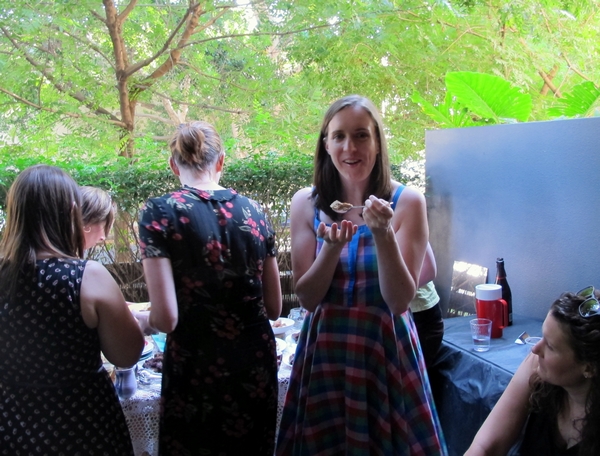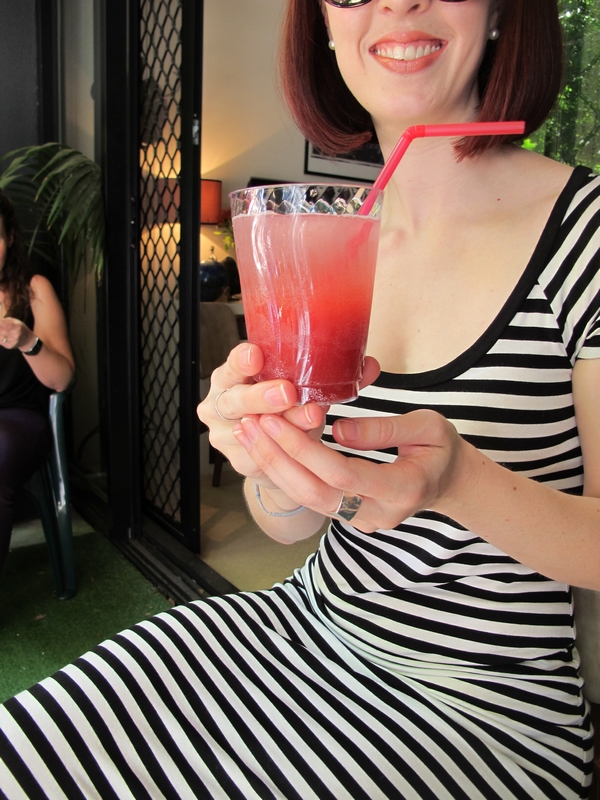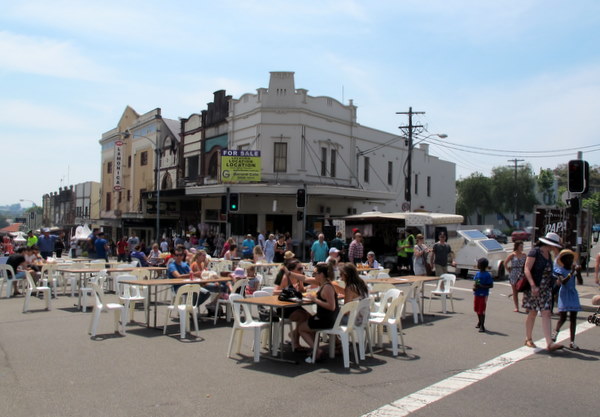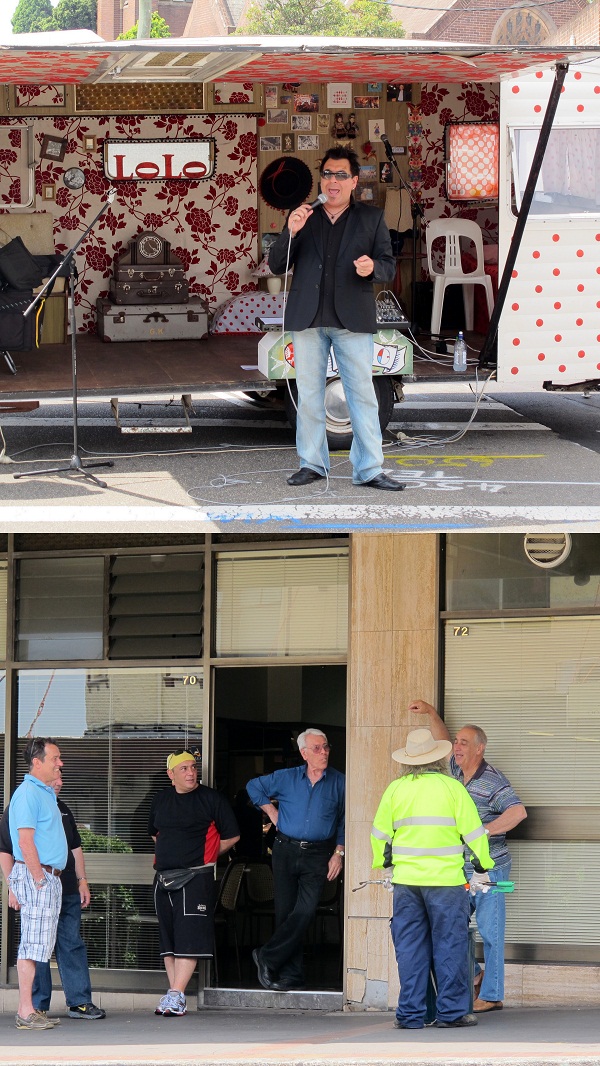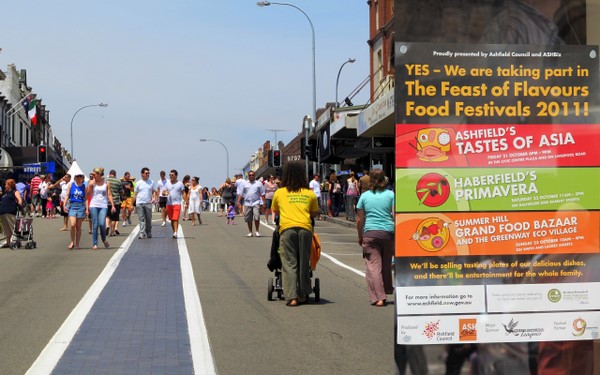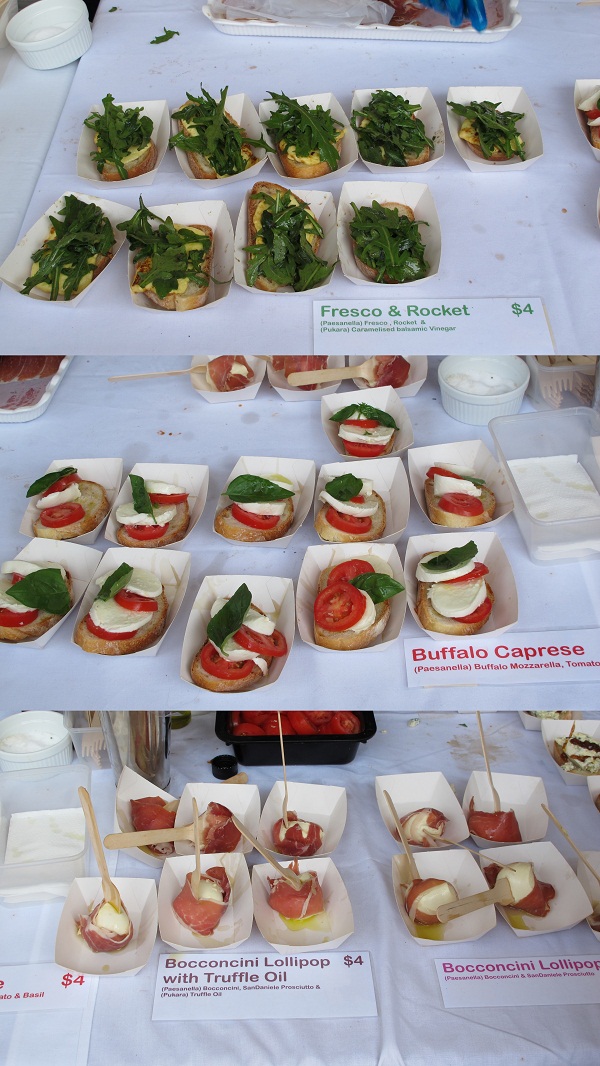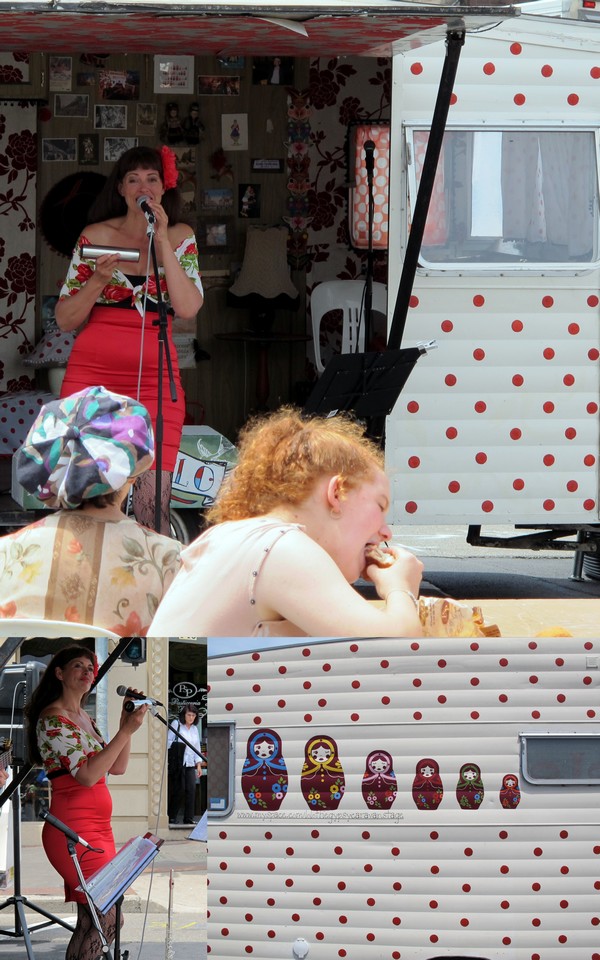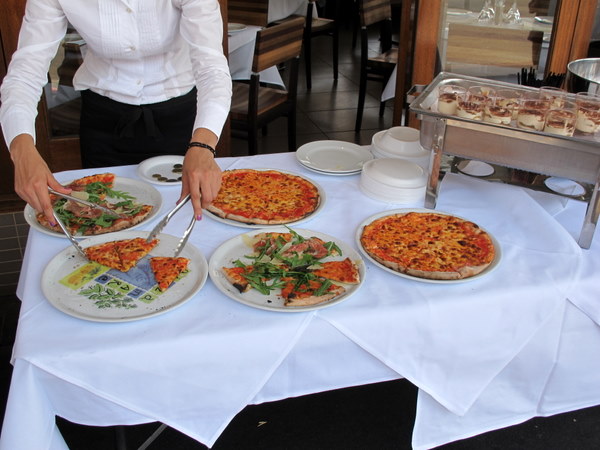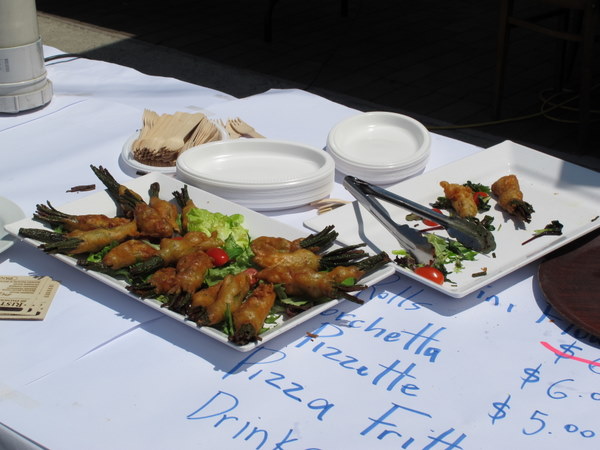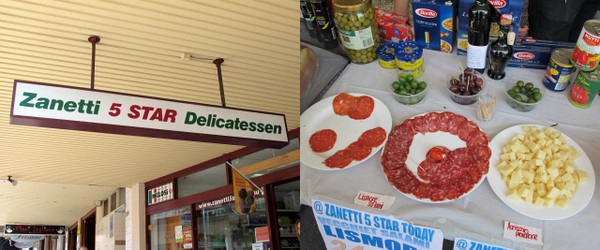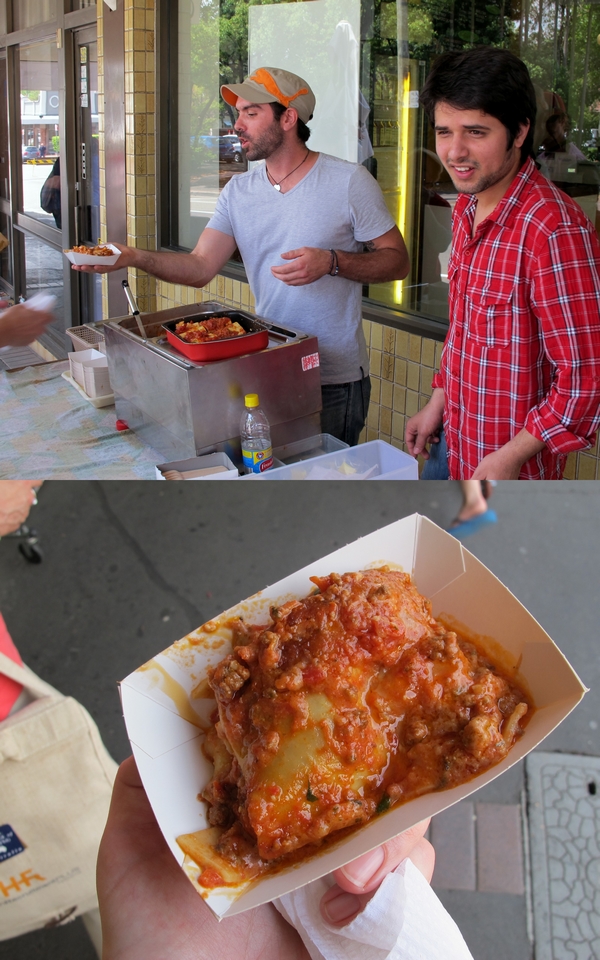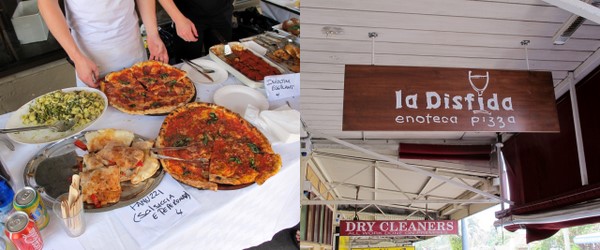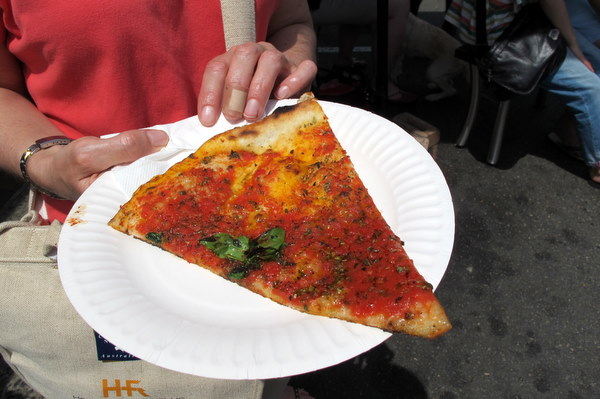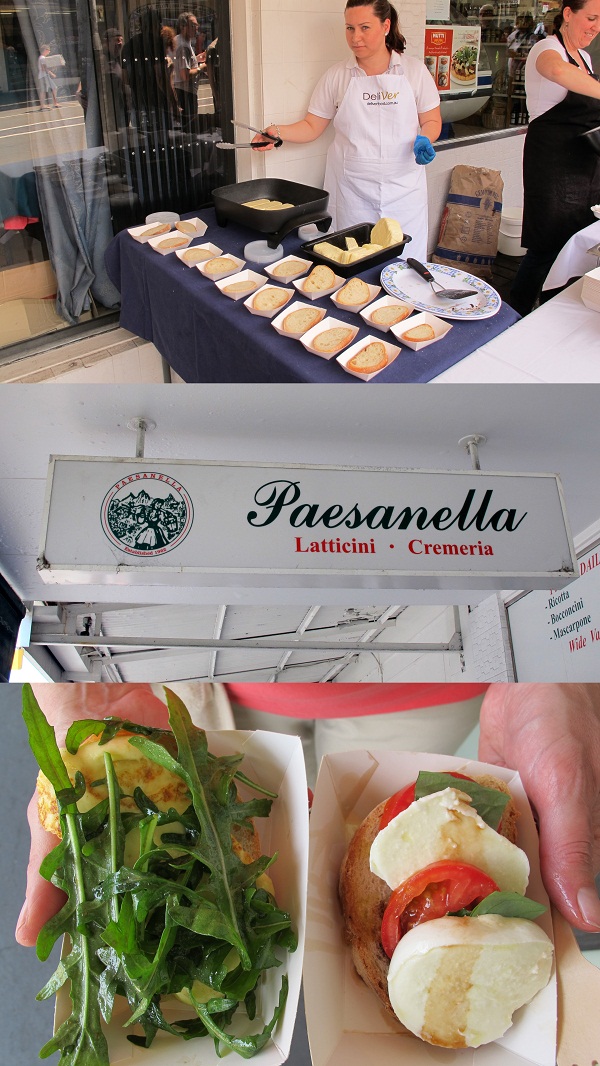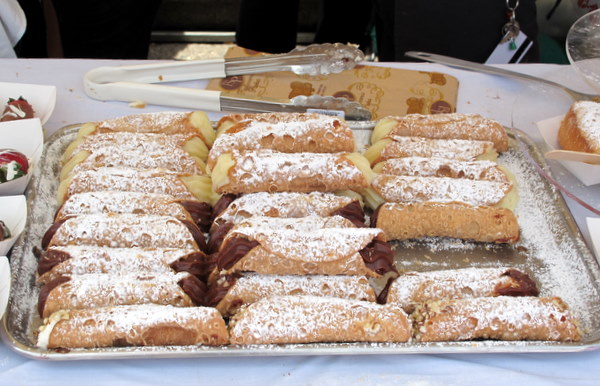I recently had the pleasure of being a guest of Noodlies and The Fairfield City Council for #fairfieldfeast, a food tour for food bloggers showcasing the Western Sydney suburb of Fairfield. All meals were free, and all meals were also, unequivocally, bloody amazing. As tomorrow is Fairfield’s ‘Culinary Carnivale’, I thought it was time to share my list of must-eats for the 2165 postcode.
Although less well known than its Viet-food-packed neighbour, Cabramatta, Fairfield is actually the most culturally diverse suburb in Australia, as a stroll around the restaurants and shops in the Fairfield ‘city’ show. Fairfield boasts Iraqi, Afghani, Chilean, Lebanese, and Lao cuisines, just to name a few.
From the city, it’s a 45 minute train trip, and everything delicious is right by the station, making for a totally walkable multicultural feast. For me, #fairfieldfeast was like eating Christmas lunch three times at six culturally diverse tables. I enjoyed every single bite.
Here are ten ace fairfield eats from the places Thang, Mel, Simon, Josie, Lee Tran, Suzi and Cindy got to visit, so you can have your own little #fairfieldfeast.
1. Arabic bread from the Afghan and Arab Bakery
Crisp on the outside, pillowy-soft within, and only 80 cents a piece to boot. What’s not to like about this freshly baked bread? It’s perfect for soaking up any soupy, dippy or saucy goodness from the bottom of your bowl.
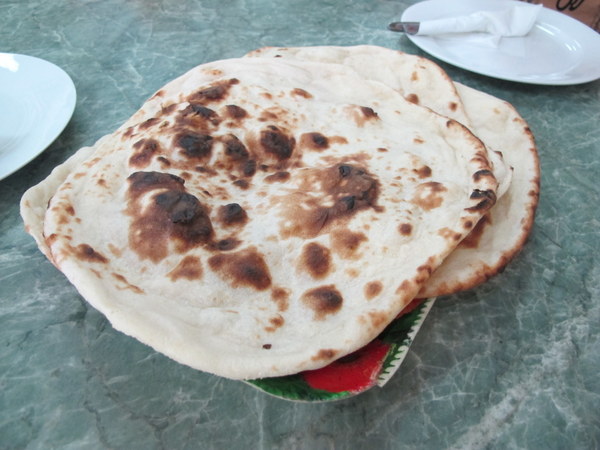
2. Chicken in adobo at Sans Rival (Mykababayan) Filipino Grocer
Mykababayan change their dishes regularly but the Adobe chicken is usually on offer. Moist and tender with a subtle soy/vinegar marinade, I was pretty impressed with my first taste of this well-known filipino dish.
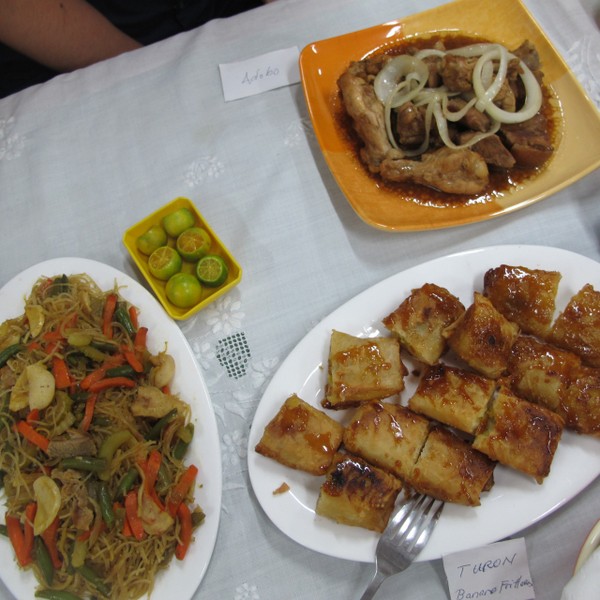
3. Chacarero y Palta at La Paula
It’s a rare day when I come to La Paula and don’t order this combo of la Paula’s own soft buns, rich mayo, fresh tomato, pickled green beans, generous slather of avocado and tender grilled beef strips. This sambo makes most burgers out there look like a joke.
4. Bread stew and crunchy salad, Al-Dhiaffah Al-Iraqi Restaurant
This slow-cooked stew is rich and tamatoey, the lamb almost falling off the bone. The strips of arabic bread soaking in the stew give the whole thing a soft, chewy texture, and the fresh tangy salad, which seems to accompany whatever you order, is a nice contrast.
5. Banana and Jackfruit Fritters at Sans Rival (Mykababayan) Filipino Grocer
There was nothing we didn’t like at Mykababayan, but the standout for me were these crispy parcels filled with soft sweet fruit and drizzled with solid strands of toffee.
6. Felafel and Toum at Frank’s Restaurant
This is felafel at its absolute best; crunchy and delicious with vibrant green innards, slathered in Frank’s special tahini sauce. Dunk it in Frank’s homemade toum (lashings of which are sold daily), the only ingredients of which are garlic, oil and salt. A better garlicky snack would be pretty hard to come by.
6. Lao Sausage and Nem khao at Green Peppercorn
My mouth *literally* does not understand either of these dishes. The lao sausage is made by hand and is packed with lemongrass, sure, but it is granular and complex in flavour in a way I just can describe. The Nem Khao had chunks of crunchy fried rice balls as well as fresh herbs and fermented pork. I think there’s coconut in there as well. Highly addictive.
9. Torta de Tres Leches at La Paula
Tres leches means ‘three milks’ in spanish and La Paula’s version is a sandwiched sponge with whipped cream and dulce de leche in the middle, iced with meringue and soaked in evaporated and condensed milk. It’s extra delicious if you either dunk it in coffee or pour a little coffee over it. trust me.
10. Pandan Creme Brulee and Deep Fried Ice cream at Green Peppercorn
Even though these were the last two dishes we ate on this massive food tour, I could not stop eating them. The pandan creme brulee was liquid smooth and coconutty with a crisp top, while the ice cream, wrapped in filo pastry, deep fried and paired with a rich caramel sauce never seemed to melt.
A huge, huge thank you to Thang Ngo and to Fairfield City Council for having me along to #fairfieldfeast.
Which is your favourite suburb for a multicultural feast?
In case you were wondering, I have decidedly unexotic and Catholic heritage- generic Irish/English stock on my Dad’s side and on my Mum’s side, half Northern Italian and half more of the same. I am, as they say, an anglo mongrel, and the food I grew up on reflects that fact. I am sometimes accused, mostly jokingly but with a dash of truth thrown in, of growing up ‘without culture’ by my partner, his heritage being a mix of Portuguese and Iraqi Jew now considered exotic.
In a way, I think as Australians we shortchange ourselves when we say we have ‘no culture’. We have every culture, that’s the point, and we can serve it all up on a plate and pretend for five minutes that we are all friends. It solves nothing, but it feeds everyone. And there are things that I think all of us who love food understand. Many of the conversations we had growing up centred on food. What did you have for lunch, what should we have for dinner, have you eaten? These are universal questions for perpetually hungry and food-obsessed families, whatever their nationality.
Food for me is mostly all about my mother. It is the same for my partner, on the phone to his mum trying to suss out exactly the right methods or ingredients to get that thing she made for him as a kid just the way she made it. If we cook something our parents used to make, and try to make it the way they would when we were kids, it is kind of ritual, a kind of homage. Whether that thing be a sausage sanger or a perfectly rendered matzo ball, we can chow down on each with equal gusto.
This recipe is basically eggplant parma, a combination of a traditional eggplant fritter recipe from my Grandfather’s family and the tomato sauce that we would eat in some form at least once a week when I was growing up. I would happily subsist on slow-cooked tinned tomatoes for the rest of my life, and this is one mind-numbingly delicious way of serving it.
Eggplant Parmigiana
Serves 8 generously, if served with salads and sides.
2 enormous eggplants, cut into ½ centimetre slices
1 egg, lightly beaten
1 cup flour
1 stale baguette, blended in the food processor
olive oil, for shallow frying
Extra virgin olive oil
2 small onions, finely chopped
pinch chilli flakes
pinch salt
6-8 cloves garlic, finely chopped
4x 400g tins chopped tomatos
1/2 cup red wine
2 sprigs rosemary (optional)
500g mozzarella, sliced
150g good quality parmesan or romano cheese, grated
Tip: You can either make the sauce first or take the ‘do everything at once approach’ outlined below, just keep in mind that the sauce should cook for at least an hour. The whole dish can be made a few days in advance; once everything is layered together, refrigerate and when you want to serve it, bring it up to room temperature before cooking.
Salt the eggplant slices well, layer on a plate and place a heavy object on top. Arrange three bowls on the bench, 1 with the flour, 1 with the beaten egg, and 1 with the breadcrumbs. Leave the weighted eggplant slices to sit for 20 minutes.
Heat the oil in a large pan. Cook the onions until translucent, then add the salt, chilli flakes and garlic. Cook until all ingredients are done but not brown. Add the wine to deglaze the pan, cook a couple of minutes. Add the tomatoes, give the tomato tins a bit of a rinse and pour the resulting water in too. Simmer the sauce for 45 minutes – 11/2 hours, adding in the rosemary about halfway through.
While the sauce is simmering, rinse the eggplants and pat dry. Heat the oil in a large frying pan to shallow fry the eggplant. Then it is just a matter of dipping each eggplant slice in flour, then egg, the breadcrumbs and popping them into the oil. Turn each slice over so it browns on both sides, and when done, put the slices on a plate lined with paper towel to drain well. This process takes about the same amount of time as simmering the sauce.
Remove the rosemary from the sauce, give the mixture a quick blitz with a stick blender if too lumpy, and leave to cool.
Preheat the oven to 180 degrees C. In a large baking dish, layer the sauce, then the eggplant slices, then the mozzarella and then the parmesan romano until the dish is full or the ingredients are exhausted – whichever comes first. Bake for around 45 minutes or until the top is browned.
Do you have a favourite family recipe?
There was a time not long ago (pre-Corridor Kitchen) when I wondered if I had lost the ability to come up with ideas. Seems crazyhorse now, but not all that much was going on and it seemed like not all that much ever would be. It’s obvious to me now that ideas don’t come from nowhere; creativity isn’t bred in a vacuum. Ideas spawn ideas spawn ideas, until one day you look at your calendar and there is literally not a spare space left. And ideas often involve more than just you and your brain; they involve other people.
When I met up with Katie at The Rag Land what seems like aaaaages ago (but really it was only January), it was a lot like when Elise told me her idea for a cookbook and The Potluck Club was born. It was a meeting of the minds in the truest sense, both of us at a loose end, talking about what we could do, what we could make, together. Because that’s all creativity really is – doing and making things.
We talked about so many things over those few weeks, but we kept coming back to the idea of gathering together, and of people (not brands or buildings or money or even food) being the essence of a good party. And so Pigeonhole Gatherings was born, Swah designed us the perfect logo, and the rest is history.
So what are we? Well, I’ll quote direct from Katie for this. ‘Pigeonhole Gatherings runs and promotes small, local, low-cost and free events centred around arts, culture, food and most of all, people. It’s already awesome and we are so excited!’ (Italics all mine). In a nutshell, we’re all about people coming together to do stuff. We fill the spaces that aren’t used 24/7. We could host a dinner in a local cafe. Or a wine tasting in the park. Or a life drawing class in an old warehouse. Or a how-to-sew workshop in a local high school. Or, our first gathering last week, a potluck at my house.
So last weekend, a bunch of people (orright, mostly food bloggers, but food bloggers are people too) met to share a meal in the kind of space we don’t see each other in all that often. It was an amazing day, and the food was more delicious than I ever could have hoped. We donated spare change to The Stephanie Alexander Kitchen Garden Foundation, and I think everyone had a grand time. But what struck me most, as we squished onto my sunny balcony and ate ourselves silly, was just how little was actually needed to make this happen, and how little inconvenience 10-or-so people gathering in my house caused. It was an absolute joy, and reminded me of why I started Corridor Kitchen in the first place – neccesity is the mother of invention. If I can cook a fabulous meal in my mouldy old corridor, the possibilities are pretty limitless. This is the next step.
Huge thanks to everyone who came out and contributed, including food bloggers Swah, Tara, Megan, Flick, Hayley and JJ.
And our next event? Yes, it is food related; a charity cake stall/bake sale, date and venue to be decided.
And yes, Pigeonhole Gatherings is all about ideas. So join us on Google+ and Facebook and share yours. And share your gatherings!
Every year I make a pilgrimage to our nation’s capital for The National Multicultural Festival, and every year I am oh so glad I did. This year it ran from the 8th to the 10th of February, and with 50 new stalls added to the lineup, I was curious to see where they’d fit them all…
Our first stop was LSR 23, Lonsdale Street Roasters’ second café. 23 Lonsdale Street houses their roastery, has a reduced menu and an order and pay at the counter policy. They also do something I will never for the life of me understand- make you collect your own have-in coffees. In the time it takes them to yell ‘Fabio’ eleventeen times, they really coulda just brought you the damn coffee. But hey, whatever gets you caffeinated, right?
My assembled companions for our initial Multicultural feast included, from left to right, my bro+chum, fake Sis-in-Law+chum, and partner+chum, as per usual, all stylishly attired and with grimaces (and forks) in hand.
At the Multicultural Festival, it’s always a tough call as to where to start, because you know there’s only so much room in your belly to eat your way around the globe. As it was noonish, we were more than peckish, and hit up the Peruvian stall post haste. Thank god we did. A new addition to the festival, they were serving up mashed potato, stuffed with chicken, boiled eggs and spices (similar to a tamale) deep fried and slathered in salsa. Just incredible- crisp on the outside, fluffy on the inside, with a mild vinegar-and-chilli zing from the salsa. This was my favourite dish of the festival.
We were severly tempted by the yeeros (pictured), considered joining the miles-long queue at the Gloria’s stall for grilled sardinhas (sardines), an, as always, lingered longingly at the Ethiopian stall watching people mop up their stew with pillowy injera. But we passed them all by, meeting up with Canberra coffeehead Barrista Barrister to try something new.
I’d never had Samoan food until this plate. I have to say that although it looks ugly as sin, it is also delicious as sin. Roast pork with plenty of crackling, gravy, samoan chop suey (stir-fried noodles), taro cooked in coconut milk and mashed purple kumara make for a veritable starch-fest. I think we were all glad we shared this between three.
We were intrigued by the pickles on sticks on offer at the German stall, but as we were going easy on the alcohol and the pickles came with beer, sadly, it wasn’t to be.
OK so I have to admit we hit up the famed loukoumades stall twice, but in my defense, it was because the first lot weren’t dark and crispy enough. The second lot, we shared with my mum, so I guess we had parental permission. Yeasty puffs of deep-fried dough squirted with honey and dusted with cinnamon and crushed walnuts, that second plate really hit the spot.
Another favourite of ours is the Bhutanese stall. We grabbed some momo, cheese-laden veggies, meat curry, rice and chilli sauce and scoffed away like there was no tomorrow. Their combo plate is one of the best value dishes on offer, and the people manning the store are lovely to boot.
If you’ve never been to The National Multicultural Festival (or even if you have), I highly recommend it, if only for the food. My year of eating just wouldn’t be complete without it.
Past posts:
The National Multicultural Festival 2012
The National Multicultural Festival 2011
in which I respectfully disagree
At the third annual Eat Drink Blog conference this year, blogger Tammi Jonas and chef Simon Bryant ran a panel discussion on local and seasonal food which quickly became a discussion of food ethics. Controversially, both agreed that they would not refuse a meal served to them by their host, even if it clashed with their principles.
I want to briefly examine the line of argument that says if someone serves you up a platter of something you can’t stomach or have an objection to, it is more disrespectful not to eat it than to eat it. Please note I mean no disrespect to either Tammi Jonas or Simon Bryant. The decisions they choose to make regarding food are up to them.
“Refusing hospitality is rude/ungrateful/inconvenient/impolite/makes people uncomfortable.”
This argument holds that basically, you should eat what you are given. It was the way I was brought up myself – the idea that it is rude to be picky, it is impolite to make people feel uncomfortable and ungracious to refuse their hospitality. I don’t agree. I see no reason why a vegetarian refusing a slaved-over meat dish at a dinner party is any more offensive than someone telling a vego or vegan that their much agonised-over food ethics are ‘inconvenient’ or ‘ungrateful’.
There seems to be an assumption here that somehow, your host’s comfort outweighs your comfort as their guest. The whole thing is totally backwards. The idea of hospitality is that as a host, you do not want your guest uncomfortable, unhappy, or traumatised by the food you serve them. If a vego or a vegan or a ceoliac or a picky bastard shows up unannounced, you do your best to do what you can so that they don’t starve. (Mind you, if guests have zany last minute dietary requirements, they may have to go hungry, as it is completely rude to storm in and demand to be catered for).
And there are times when politeness is actually inappropriate. When someone makes disgusting remarks, or racist jokes for example, or when someone threatens you or someone you love, politeness goes out the window, and it is time to say ‘Fuck you, mate,’ or words to that effect.
This is not to say your friends’ bbq presents you, the vego, with a chance to lecture them for supporting factory farming. But the mere fact that your vegetarianism may be an inconvenience doesn’t in any way mean that you’re wrong for not chowing down on that homebrand sausage in its blanket of cheap white bread, marge and super-sweet tomato sauce, any more than you would be wrong for not laughing at someone’s racist joke. Politeness doesn’t trump all.
Cultural Relativism – “When in Rome…”
I once met a vego who stopped being one after travelling through South America. To a tourist, the Argentinean streets seem lined with steak and vegetables are often hard to come by. In some parts of the world, vegetarianism is something they just won’t get. Don’t want to offend a whole Colombian village? I get it. Suspending your ethics temporarily because all you’ve had to eat for the past month is mashed potato? Understood.
However, I disagree with the idea that it is intrinsically wrong to upset a group of people because they all believe the same thing. Yes, you should always be respectful of other cultures. You shouldn’t mock or ridicule people for not behaving the same way as you, if only for your own safety. But you do not have to agree with every cultural practice of every cultural group, simply because you are not from that culture. Furthermore, you should not have to participate in activities that completely undermine your own values.
What if one of their cultural practices is slowly and agonisingly killing a goat and drinking its blood? Or greeting people by punching them in the face? If you’re not allowed to disagree with those practices, or if you cannot choose non-participation, then neither can anyone within that culture, and thus the culture cannot change and evolve. If someone believes very strongly that eating meat is the wrong thing to do, I see little point in guilting them for not eating that guinea pig their host offered them in Peru.
“It’s already dead, so why waste it?”
This is by far the most ridiculous argument of all. For someone to choke down the scraps of meat left on the table simply because they are there makes no sense. No one should eat something they don’t want or need. That is a different kind of wasteful. That is gluttony.
And to argue that throwing away meat is disrespectful to the animal that ‘gave its life for you’? Ok, maybe it is disrespectful in some sense. Maybe it is wasteful. But let me tell you that animal did not ‘give its life for you’. It did not die for your sins. Someone killed that chicken/pig/goat/sheep, whether cruelly or kindly, and you are about to eat it. The animal is dead. It doesn’t give a flying fuck whether you gobble up its carcass or throw it in the bin. Sorry to be harsh, but there you go. There is only one sense in which ‘honouring’ the dead animal is of benefit; that the community attitude towards animal cruelty can be changed for the better. Other than that, it is pure speculation.
Why not just be flexible? It’s not black and white.
Of course it is not black and white. You are free, if you like, to never eat pork, except on Tuesdays, be wheat sensitive only 27 days out of the month and only drink milk ‘when you feel like it’. I’m sure people do it.
But for many people, being vego or vegan boils down to making a black and white decision to save themselves from making a zillion tiny grey decisions each day. ‘No meat’ for example or ‘No meat and eggs’ or ‘No animal products.’ This is a simple way for them to guide their daily eating.
A vegetarian may acknowledge that there are well treated pigs out there, that some crops could be harder on the planet than some herds of animals and that there are better and worse ways to kill and pluck a chicken. But they make the choice not to eat meat/dairy/whatever and they live by that choice.
So, where to from here?
To my mind, the kindest thing you can do for your host is be clear. Ethical eating is evolving. But to your host, ‘Sorry, I don’t eat meat’ is a hell of a more simple/kind/polite/straightforward/easy to digest message than. ‘Sorry, I don’t eat factory farmed pork, food from any of the major supermarkets, non-organic vegetables, and milk makes me feel slightly queasy.’
Just by having an ethical stance on food, it is expected that yours will be perfect. But it doesn’t have to be. If Simon Bryant is on a road trip in the middle of woop woop and buys a mars bar from the 7 11 , he is no less of an ethical eater. If Tammi Jonas comes to my place and eats the factory farmed pork roast I serve her, she is no less of an ethical eater. They are in environments where they have little control over their food choices and they are doing their best.
By the same token, if Tammi refuses my pork roast, sure, I’m kinda embarrassed, but so what? I’ll get over it. If eating that pork roast was going to totally compromise her values and break her heart, I can honestly say I’d rather be mortified than have her eat it.
And when in doubt, you can always just say ‘I’m allergic.’
Whenever I get the chance, I make the pilgrimage to Melbourne, or, more correctly, to Western Melbourne. The shrine I seek has nothing to do with religion, but it has a spirituality all of its own. I seek something no Sydneysider can find on their back door step, something no amount of Harbour Bridges and sunny (ish) days and schooners and middies can make up for. I seek…injera.
For those of you who haven’t had the exquisite pleasure, injera is a large crumpet-like flatbread that forms the foundation (literally, it sits under all the other food, tablecloth-like) of Ethiopian and Eritrean food. Stews (wats) are daubed on top of it and you tear of bits of the injera and scoop them up by hand. It is traditionally made using teff flour and thus has a delicious sour flavour.
On my most recent pilgrimage, I caught up with Lauren of Footscray Food Blog, which I’ve been reading and eating from ever since my brother moved to the outer edges of Footscray. She offered to meet up at ‘lovely local place’, Adis Abeba. I could almost smell the fresh sponges of injera and feel them squish between my teeth. I couldn’t wait.

I arrived at the lime green Addis Abeba for our late lunch to find Lauren already there and no other customers. Lauren ordered (she’s the guru after all) and we proceeded to delve into talk about life, blogging and, of course food.
The veggie combo was amazing. For $12 there are 6 delicious curry-like stews to scoop up and munch. As we eat, the injera underneath get deliciously steeped in juices. But don’t worry, we have a whole massive bowl of injera in case it gets too soggy.
The other dish we order is the spacial tibs ($12), a gorgeous buttery lamb dish that comes out sizzling. We ladle it onto the platter as well, pinching up handfulls with the fresh injera.
After my visit to Adis Abeba, I feel like I’ve graduated from Ethiopian food pilgrim to devotee. So much so that my brother and I return the next day and ordered the exact same dishes. And we also hit up Mesnoy Injera Bakery afterwards, so we could serve injera at bro’s house party.
A big thankyou to Lauren Wambach for hosting me in her ‘hood. See Lauren’s post for a better description of the dishes we ate.
What food would you travel halfway around the world, or at least across town, to savour?
Addis Abeba
220 Nicholson Street
Footscray, VIC, 3011
(03) 9687 4363
addisabeba.com.au
The National Multicultural Festival is held each year in Canberra, and as far as I’m concerned it’s the best food fest in Australia. This year it ran from the 10th to the 12th of February.
Nepalese Momo (dumplings). Some were filled with lamb, some with veggies. The accompanying sauce was extremely hot.
Ethiopian. We had this as our morning tea. There’s a potato and cabbage dish, a lentil stew and I want to say key wat? And of course, blissfully crumpety injera.
OMG, the Sicilian stall! They only sold sweets and I coudn’t resist. We tried this custard filled fried morsel, yum!
All that eating makes you pretty darn thirsy. Luckily there were free water bottles and free water.
Vietnamese drinks.
Sausages on the grill…
…and a sausage dog in a bag!
As you can see, it’s a pretty popular place to be.
The line for the Loukamades (greek doughnuts) is always massive. They weren’t as deliciously crispy as last year though…
A papusa from one of the Mexican stall. A cornmeal based thick tortilla, in this case filled with cheese.
And a delicious chicken tamale.
Which is your favourite food festival?
You can read last year’s post here.
They let their food go cold. They rock fancy SLRs. They tweet up a storm, posting photos of their on-trend lunches and they always know where to get a good feed. Here are five facts about food bloggers you may not know.
1. They hate food fads just as much as you do
Macarons. Masterchef. Those over-blogged ‘it’ restaurants. Food bloggers have been there, done that, or at least read it in their mile-long blogroll. At EatDrinkBlog, one food blogger admitted to me, in hushed tones ‘I don’t think macarons are that great, actually.’ I had another prominent food blogger email me to agree that Sydney’s recent night noodle markets were both overrated and lacking in noodles. Chances are your fave food blogger is as sick of hearing about Jamie’s Italian as you are…or soon will be.
2. They’re zeitgeisty, not trendy
Food bloggers will break the next big thing months before the more cautious mainstream media. By taking risks, readers feel they get the inside scoop and other bloggers can follow suit and put in their 2 cents. As a rule, food bloggers don’t blog an experience they’re not that enamoured with, unless it’s macarons, possibly served at the night noodle markets by one of the contestants of masterchef, so the initial buzz bloggers create is often well-deserved.
3. They work extremely hard at what they do
Blogging requires consistent effort, especially for big name bloggers or those who have successfully monetised their blogs. Once readers regularly stop by or start paying for content, it becomes even more important to provide consistent, quality stuff. Food bloggers know they have to bring their readers something fresh and new that they can’t find on their own. A full-time blogger may work around 15 hours a day, 6-7 days per week. I myself spend about 8-10 hours a week just to produce 1-2 posts.
4. They’re often not as tech-savvy as you might think
Bloggers aren’t all tech heads, nor are they all graphic designers. When figuring out how to do something tricky on their blogs, the default method? ‘Google it’. I’m really glad I’m not alone in this, as along with visiting forums, it’s the method I usually use. Another thing I’ll do is to get in contact with bloggers who have a feature on their blog I particularly like, and ask them where they got it. Food bloggers are usually more than happy to share their knowledge and help you out.
5. They’re not all trying to get published in mainstream media
It’s often assumed by those outside the blogging community that bloggers are trying to get published in a ‘real’ medium. For some, this may be the case – they may be after freelance writing jobs or book deals. But for many, blogging can be a hobby, or it can be a business, it can be just plain fun. I know for myself the motivation is producing something, publishing something myself.
Sydney food bloggers suffer from the paradox of choice. We are presented with so many food choices, trends and fads that sometimes we become paralysed. We can’t decide what to have for dinner. It’s a hard life.
Last weekend, having just finished up The $35 Challenge where there was very little in the way of food choice, I was far from paralysed by this paradox. In fact, I was salivating, and not even necessarily at the variety of food offered up by the harbour city, but at the very concept of choice itself. Now. What to eat first?
I knew exactly where my first foray back into foodie-ville would take me. A week or so ago, after a tip-off from kindred blogger Inner West Foodie, I got an email from Ashfield council inviting me to its three upcoming festivals: Ashfield’s Tastes of Asia (Friday night), Haberfield’s Primavera (Saturday) and The Summer Hill Grand Food Bazaar (Sunday), all part of the Crave Sydney Food Festival. Friday I was still on The $35 Challenge and Sunday the inner-west trains weren’t running so I knew I’d be at Haberfield come Saturday. It was to be my only Crave Sydney Food Festival event, and one I’m glad I didn’t miss. Haberfield isn’t a suburb I’ve spent much time in, so I welcomed the chance for a bit of exploration. And with Ashfield Council promising 100% local stallholders (specifically, no gozlëme) I was hooked.
These days, no matter how awesome the food festival, there are always your usual suspects. I’ve written about it before, but there’s your tapas stall, your gozlëme, your poffitjes. You’ll find them at the night noodle markets, at the Campsie Food Festival and the Glebe Markets. Ok, there’s a reason they’re so ubiquitous – they’re solid crowd pleasers. But I think that markets and festivals have a brief, a theme, and I think they should stick to that brief. If the theme is noodles, there should be noodles. If the theme is, say, a suburb, the festival should be made up of businesses from that suburb or at least that area. If the theme is a country or region, there should only be stalls serving food from that region.
I applaud Ashfield Council for sticking to its own brief. Haberfield’s Primavera was made up entirely of businesses from Haberfield – in fact, I think it was made up entirely of businesses from the Ramsay and Dalhousie streets. It is quite a small festival, so maybe that will change as it garners more interest. But I hope not. Aside from The National Multicultural Festival earlier this year, it’s one of the only food festivals I’ve been to that has truly stuck to its own brief.
When I arrived, there wasn’t much to see. Ramsay and Dalhousie streets were blocked off with a caravan stage in the middle of the crossroads with everything quite spread out. This is because the stalls were located directly in front of businesses, which I thought was a fantastic idea. It meant that the stallholders could cook in their own kitchen if they wanted and punters would easily be able to return for a meal sometime if they liked what they tasted.
The point of Haberfield’s Primavera is to showcase the flavours of the local area. To this end, everything served was in very small portions, with nothing costing more than $5. This made it not only affordable, but (my favourite part) it meant that you could try many different dishes without feeling like a huge, ridiculous whale at the end of it. For the businesses involved, it also ensured the maximum number of customers would get to taste their food. It’s impossible to object to eating a small $4 treat sitting in the gutter on a beautiful spring day, let alone several treats. Thus, Haberfield Primavera managed to circumvent the much uttered criticism of ‘But I could pay $15 to eat that in a restaurant! Why would I pay that to sit in a park/on the ground/standing in the street?!’
And I ate so many things. I started with fried zucchini flowers stuffed with cheese and anchovy from Haberfield Post. They probably needed to drain and cool a bit, I got way too excited and ate mine fast. I’d brought my (vego) mum along to take photos and she said ‘Oh…I think that had and anchovy in it.’ Damn, Italy, always with the secret fish. Ah, well.
At the Zanetti 5 Star Delicatessen they had free samples of olives, salami and cheese. We tried the Sicilian green olives marinated in lemon and garlic and vowed to go back and buy a tub. Out the front of the iconic Lamonica IGA where an old man played the piano accordian I grabbed a $1.50 espresso which was heavy on the crema but also on the bitterness. Ah, well. You get what you pay for, I guess.
At La Pasteria they were selling two things: meat lasagne and spinach and ricotta cannelloni. I grabbed a lasagne, it was pretty greasy but in a guilty pleasure kind of way, super rich, cheesy and tomato-y. At the same time, the flavours were very simple; just folds of pasta and cheesy Bolognese. Heaven.
I lost track of how much time we spent staring at and photographing the gorgeous Italian pastries, cakes and savouries at the Pasticceria Papa stall. They had cannoli, their famous ricotta cake (which I vow to try next time), gorgeous looking thin squares of pizza, arancini the size of which I’d never seen before, sandwiches, biscuits and god knows what else. As there were still more salty snacks to try, we decided either to return at the end or, if not, to join the ever-lengthening queue for gelato at an as-yet-unopened gelataria.
We considered tasting some wine at Haberfield Cellars, but found ourselves drifting straight past to the stall at La Disfida. This stall would definitely win the award for the most varied and interesting looking food, it’s was actually really hard to decide what to eat; there was amazing looking orecchiette, eggplant involtini, Panuzzi, arancini with mushroom, rocket and truffle, peperoni pizza, and, something I wish I’d had room for, Italian doughnuts. We opted to share a slice of margherita pizza, cheeseless but to die for. The tomato was rich and balanced, the crust perfectly cooked, with just enough herbs and olive oil to finish it off.
Next up was the Paesanella Cheese Shop which makes its own cheeses. They were selling three kinds of bruscheta; fresco and rocket, buffalo caprese, and a blue cheese and marscapone mix. They were also selling bocconcini ‘lollipops’ wrapped in prosciutto. The stall was such a simple idea but it was so effective in showing off Paesanella’s range of freshly-made cheeses. We grabbed a fresco and a caprese to share, the fresco was pan fried and salty with fresh crusty bread, offset by the peppery rocket and a dash of vinegar, while the buffalo mozzarella had a fresh, clean but still salty flavour. The tomatoes used were perfectly ripe.
We finished things off with a ricotta canolli from the aforementioned Pasticceria Papa. It had an amazing crunch to it was disappointingly bland in flavour. Sicilian olives in hand we headed for home, satisfyingly filled and pretty impressed at what Haberfield Primavera had to offer. I will definitely return next year.
When it comes to food, do you suffer from the paradox of choice?
There’s an interesting phenomenon in Argentina. You have your age-old coffee culture, your beautiful ornate cafés all over Buenos Aires, the daily Argentinean ritual of morning and afternoon (or evening) coffee. And then you have your ‘coffee’.
The espresso here is, dare I say it, terrible, and many extranjeros will agree with me on this. It doesn’t matter what your order – cafe con leche (flat white), espresso, cappuccino, it will be scaldingly hot, weak as piss and watery to boot. So you’ll be sitting in a cafe, be it dingy or grandly ornate, and you’ll decide it’s time to give up on coffee altogether. And there’s plenty of time to make that decision, as the time between a mozo setting down your coffee and it being cool enough to take a sip averages 10 minutes.
I was here 2 years ago so I knew all this before I came back, but memory is a tricky thing and I fooled myself that somehow, somewhere I would find a decent espresso. I’m sure there’s one out there, somewhere. But I’m yet to discover it.
If anyone has any coffee (not café) recommendations for either Montevideo or Buenos Aires, sock it to me.
About me
 Sharing easy recipes, hunting down the best coffee. Honest accounts, nothing too serious. Read more...
Sharing easy recipes, hunting down the best coffee. Honest accounts, nothing too serious. Read more...Recent Posts
- Aerpress means no more shit #travelcoffee and #workcoffee
- Why I write and four ace bloggers who do it better
- The five best things I ate in London
- Shoreditch is awesome, airports are not
- I quit sugar? Do I bollocks.
- Cubao Street Food, Alexandria
- The Reformatory Caffeine Lab, Surry Hills
- Brewtown Newtown
- Stay caffeinated over Christmas
- Gumption by Coffee Alchemy, Sydney CBD
Popular posts this month…
 Review – Philips Saeco Intelia posted on January 10, 2012
Review – Philips Saeco Intelia posted on January 10, 2012  The quest for Mex part 2 – Feisty Chicken Burritos posted on December 21, 2010
The quest for Mex part 2 – Feisty Chicken Burritos posted on December 21, 2010  Café Review – Petty Cash Cafe, Marrickville posted on May 31, 2011
Café Review – Petty Cash Cafe, Marrickville posted on May 31, 2011 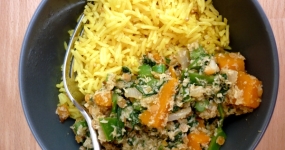 Sri Lankan Spinach with Coconut posted on December 10, 2010
Sri Lankan Spinach with Coconut posted on December 10, 2010  Lemonade Scones and family recipes posted on February 25, 2011
Lemonade Scones and family recipes posted on February 25, 2011  Sparkling Long Black posted on May 10, 2011
Sparkling Long Black posted on May 10, 2011  Salat Hatzilim posted on January 28, 2011
Salat Hatzilim posted on January 28, 2011  Kosher Whole Orange Cake posted on July 5, 2011
Kosher Whole Orange Cake posted on July 5, 2011
Disclaimer:
All opinions in this blog are mine, an everyday, real-life person. I do not accept payment for reviews and nor do I write sponsored posts. I do not endorse the content of the comments herein.


